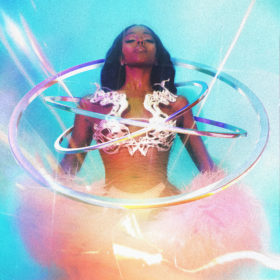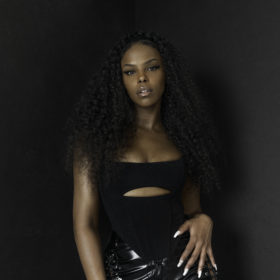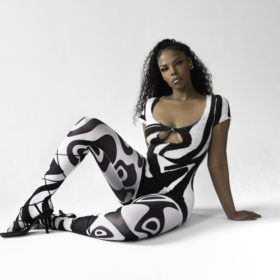Amaal has been dreaming up a world of her own for some time now.
For most of her life, the Somali-Canadian singer was constrained by rigid expectations of womanhood as a result of her conservative upbringing. She grew up in Toronto as the fourth of 10 siblings, after her family fled the civil war in Somalia in the 1990s. For years, Amaal felt the limitations of simply existing with a multitude of identities. But now, she’s created a vibrant universe that celebrates them in her sophomore EP Milly.
The R&B artist spent many sleepless nights building vision boards on Pinterest to create her utopic universe. “I asked myself, ‘What would a world look like where people didn’t have to conform to the identities given to them?’” she recalls. Influenced by ‘90s and early 2000s futurism, Milly’s stylistic world is filled with saturated colours, chrome visuals, and self-assured lyrics delivered through smooth vocals.
Released in October 2021, the EP is an unapologetic exploration of femininity, orbited by themes of sexual release, vulnerability and unabashed self-expression. And on April 29, the 32-year-old singer debuted another track: the extended single “Lullaby.” The song, featuring artist Syd, builds on Milly’s empowering universe by exploring fearless professes of love and lust.
In crafting a liberating universe of melodies and meanings, Amaal has found an otherworldly sense of power. After the release of “Lullaby,” the artist spoke with FASHION about using imagination to confront oppression, stepping into the Afrofuturistic renaissance and embracing every part of her femininity.
What was the inspiration behind the futuristic visuals of Milly?
I wanted to [create] what I thought the future could look like. A lot of my music is about confronting the misogynoir and all the old oppressive ideologies that have constrained me most of my life. My music helped me discover the woman I’m meant to be. But it has taken all these years for me to get to this point. So I asked myself, “What would a world look like where people didn’t have to conform to the identities given to them?” And this is what I kept seeing. It was very otherworldly, cosmic and beautiful.

Your work has been characterized as being part of the “contemporary Afrofuturist renaissance.” How would you describe this movement?
It’s this essence of Black people taking over, sharing, using their voices and putting their print in their art. Their identity is present on it without being remixed by someone else or being told, “Oh, this is too much.” It’s completely living, being and doing what we love. I really just wanted to be a part of that. I wanted to get my art out there, and do it in a way where I was challenging these [constraints] that I was up against during most of my life. I just think it’s unapologetically existing.
In the world of Milly, what are the values and laws at play?
Self-expression. Not having to conform. Not having to censor yourself. Of course peace and love, but also there’s nothing wrong with a little bit of contention. It’s okay to be confrontational and set your boundaries. It’s about being able to create what you want, love who you want and express yourself without judgment. That’s what I’ve always wished for myself, because I always felt like I had multiple identities. Being from Somalia, being a Canadian girl, and being Muslim, I felt I had to choose. But I’m all of these things; it’s my story. I see the rules in my world looking that way. But I wouldn’t even call them rules — just the way of life.
Can you describe your fashion sense in three words?
Vintage. I love recreating and refurbishing pieces into my own sense of style. Edgy. And sexy. If I can add one more, it’s masculine. I love having a suit outfit or an oversized jacket with pants.

How do you incorporate your Somalian heritage into your style?
For years, I used to wear henna. I also have all this gold jewelry from my mom that have very distinct Somali styles. The other day, I wore one of my mom’s traditional head wraps. She got most of them from her wedding; they’re a symbol of having transformed into a woman. They are beautiful scarves with distinctive red dots on them. So anybody from East Africa knows that it’s a traditional Somali headscarf that women get. I’ve worn it as a headscarf, I’ve turned it into a halter top and I’ve wrapped it around my neck. It’s little things I do to try to incorporate it.
What’s one piece of jewellery that’s especially meaningful to you?
Probably my necklace. It has my name on it in Arabic. It’s one of the first gold necklaces that my mom and dad got me, and it’s always on. I’m actually wearing it right now.

What’s the last thing you felt grateful for?
My family. We [just marked the end of Ramadan]. It’s a very holy, sacred month and we break our fast together. And every day, you reflect on what it is that you’re grateful for. To always have them there to support me, and me for them, I feel really thankful for that.
What was the last dream you had that you can remember?
Some of my beautiful dreams are about my mom. I haven’t seen her since the pandemic started. She got stuck in Somalia and stayed out there. So anytime I have a dream about her, I’m on cloud nine.
When do you feel the most beautiful?
When I’m in the sun. Other than that, it’s when I’m taking care of myself: feeding my body, reading good and just doing all the things that I need to be doing. When I’m happy, I feel beautiful.
The post There Are No Rules in Amaal’s Futuristic Universe appeared first on FASHION Magazine.
Powered by WPeMatico






